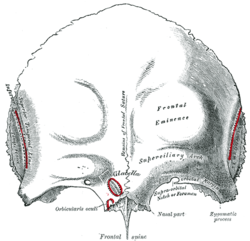Supraorbital margin
| Superciliary arches | |
|---|---|

Frontal bone. Outer surface. (Label
for "Superciliary arch" at center right). |
|
| Details | |
| Identifiers | |
| Latin | Arcus superciliaris |
| Dorlands /Elsevier |
a_58/12150739 |
| TA | A02.1.03.005 |
| FMA | 52850 |
|
Anatomical terms of bone
[]
|
|
The supraorbital ridge or brow ridge, known as superciliary arches in medicine, refers to a bony ridge located above the eye sockets of all primates. In Homo sapiens sapiens (modern humans) the eyebrows are located on their lower margin.
The supraorbital ridge is a nodule or crest of bone situated on the frontal bone of the skull. It forms the separation between the forehead portion itself (the squama frontalis) and the roof of the eye sockets (the pars orbitalis). Normally, in humans, the ridges arch over each eye, offering mechanical protection. In other primates, the ridge is usually continuous and often straight rather than arched. The ridges are separated from the frontal eminences by a shallow groove. The ridges are most prominent medially, and are joined to one another by a smooth elevation named the glabella.
Typically, the arches are more prominent in men than in women, and vary between different ethnic groups. Behind the ridges, deeper in the bone, are the frontal sinuses.
The supraorbital ridges, being a prominent part of the face in some ethnic groups and a trait linked to both atavism and sexual dimorphism, have a number of names in different disciplines. In vernacular English, the terms eyebrow bone or eyebrow ridge are common. The more technical terms frontal or supraorbital arch, - ridge or - torus (or - tori to refer to the plural, as the ridge is usually seen as a pair) are often found in anthropological or archaeological studies. In medicine, the term arcus superciliaris (Latin) or the English translation superciliary arch. This feature is different from the supraorbital margin and the margin of the orbit.
Some paleoanthropologists distinguish between torus and ridge. In anatomy, a is a projecting shelf of bone. Fossil hominins, in this use of the word, have the frontal torus, but modern humans only have the ridge.
...
Wikipedia
